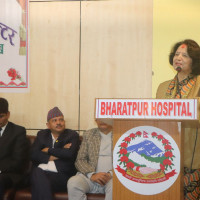- Sunday, 7 December 2025
Oxen shortage drives farmers toward modern threshing tools
BY NABIN RAJ KUINKEL,Lamjung, Nov. 14: Farmers in Lamjung are currently busy harvesting and storing paddy, but unlike in the past, the festive joy once associated with this season has largely faded.
Just a decade ago, during November and December, early morning smoke could be seen rising from the fields across the villages. Women of the house would begin preparing meals, while men worked in the fields, some threshing paddy, some driving oxen around the threshing floor, and others stacking straw into the post.
The rhythmic songs sung during the threshing days, along with the communal laughter, made the season truly vibrant.
However, such scenes have almost disappeared since threshers and tractors replaced oxen for threshing, said Umakanta Gautam, 82, of Marsyangdi Rural Municipality-9.
“In earlier times, neighbours used to gather and help each other during threshing. Turns were taken to work in each other’s fields. Today, those traditions have faded,” he said. “Modern machines have replaced oxen-powered threshing, and with that, a part of our culture has vanished.”
The shortage of oxen and the increasing use of modern agricultural tools have contributed to the decline of traditional ‘dai halne’ (oxen-based threshing) practices. Many farmers now spread tarpaulins in the fields to separate the grain using portable threshers and take the straw home directly.
Birkha Gurung of Ghirmu in Marsyangdi-5 said, “The days of coating the threshing floor with cow dung and mud, circling oxen around the post, and singing threshing songs are gone. We now use mini-tractors for threshing because keeping oxen has become impractical.”
Ben Bahadur Sunyal of Besisahar-9 said that with the rise of technology in agriculture, the old method of letting oxen trample the straw to release rice grains on clay-coated floors had gradually disappeared.
Farmers said youth migrating abroad, the lack of manpower and oxen in villages, and the rising cost of hired labour had all accelerated the disappearance of the ‘dai’ culture.
In the past, preparations for threshing would begin five to seven days in advance. Farmers would clear and smooth the largest area in the field, plaster it with cow dung and clay, set up the central post, and tie the bundles of paddy around it. It was customary to perform rituals and worship local deities before threshing began.
“Now, the younger generation seldom uses traditional farming methods,” said Sunyal. Farmers worry that if mechanisation continues to expand at the current pace, the age-old oxen-powered threshing culture of Lamjung may vanish completely within a few years.
















